Explore Haikou - China Travel, Asia
The energetic capital of Hainan Province, Haikou, is a hidden treasure just waiting to be discovered. Nestled on the northern coast of Hainan Island, this city offers a unique blend of tropical beaches, rich history, and a dynamic local culture. Whether you're seeking relaxation on pristine shores or an adventure through ancient streets, Haikou has something for every traveler. Its warm climate, friendly locals, and fascinating attractions make it an ideal destination for those looking to experience the best of southern China.
Population: Approximately 3 millions in 2020.
Economy: While Haikou's economy is mostly based on agricultural and animal exports, there is a small amount of industry, such as canning, textiles, rice hulling, and light engineering.
Landmarks: Famous for the Qilou Old Street, Haikou Volcano Park, and Wugong Temple.
China
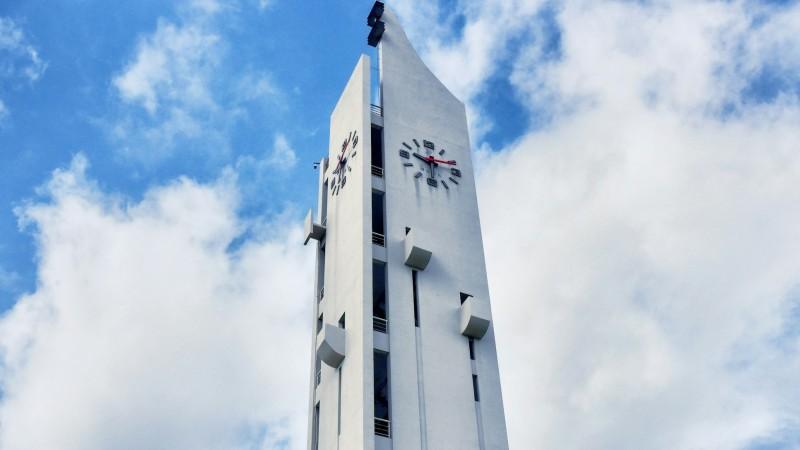
Overview of Haikou
History & Cultural Influence
Haikou's history stretches back over a thousand years, shaping it into the cultural hub it is today. Once a little fishing community, the city gained prominence as a port and a gateway to Hainan Island during the Song Dynasty. This historical significance is evident in Haikou's architecture and cultural practices, which reflect a blend of Han Chinese and indigenous Li and Miao influences. You may discover an intriguing blend of traditional Chinese stores and structures from the colonial era when you go down Qilou Old Street. The city’s many temples, such as the Wugong Temple, offer a glimpse into the spiritual life of the locals, preserving traditions that have been passed down through generations.
Interaction with the Locals
Haikou, the capital of Hainan Province, is home to a population of approximately 3 million people. The city's residents, known for their warmth and hospitality, are a mix of Han Chinese, the dominant ethnic group, and minority groups such as the Li and Miao people. This diverse population contributes to the city’s rich cultural tapestry, blending traditional customs with modern influences. The citizens of Haikou take pride in their city’s natural beauty and vibrant heritage, making it a welcoming destination for visitors.
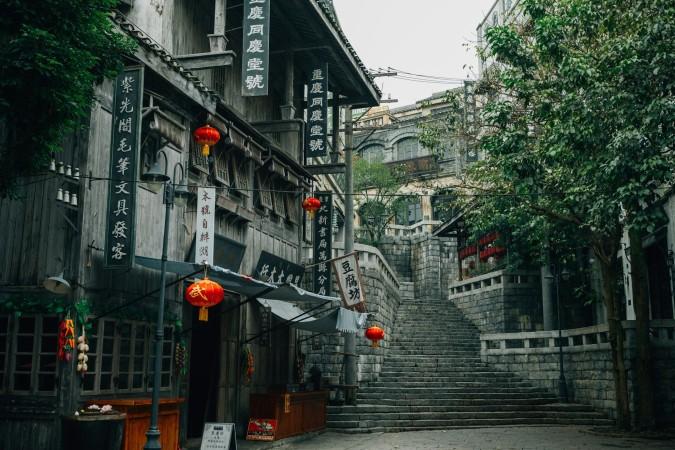
Qilou Old Street - © Denny Ryanto
Top Attractions in Haikou
Qilou Old Street
Qilou Old Street is a living testament to Haikou’s rich history. This historic area is lined with colonial-style arcades and ancient shops that showcase a blend of Chinese and Western architectural influences. A stroll down this street offers endless opportunities for photography, shopping, and sampling local delicacies, making it a must-visit for history enthusiasts and culture seekers.
Haikou Volcano Park
Nature lovers shouldn’t miss Haikou Volcano Park, a unique geological site featuring extinct volcanoes and lush landscapes. The park offers well-marked hiking trails that lead to stunning viewpoints, providing visitors with breathtaking vistas of the surrounding terrain. It’s an ideal spot for outdoor adventures and a peaceful escape from the city.
Hainan Museum
The Hainan Museum is the perfect place to dive into the island’s rich history and culture. The museum’s extensive collection includes ancient pottery, traditional costumes, and exhibits on the indigenous Li and Miao peoples. A visit here provides valuable insights into Hainan’s past, making it an educational experience for all ages.
Wugong Temple
Also known as the Temple of the Five Lords, Wugong Temple is a serene historical site dedicated to five exiled officials from the Tang and Song dynasties. The temple’s tranquil gardens and ancient architecture offer a peaceful retreat, allowing visitors to explore Haikou’s spiritual heritage in a quiet, reflective setting.
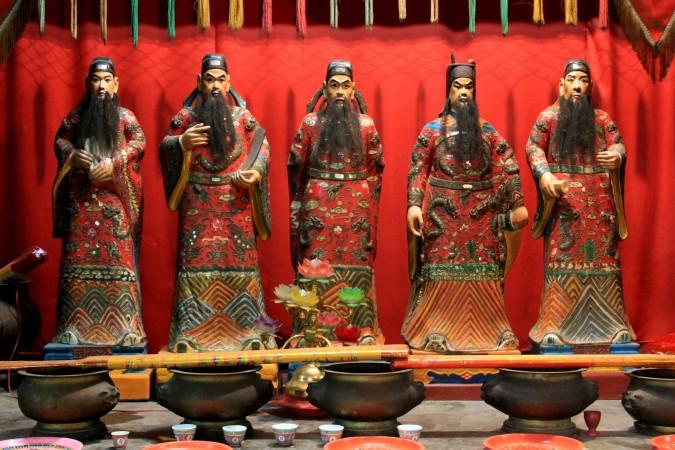
Wugong Temple (Temple of the Five Lords) - © Wikimedia
Must-Try Dishes in Haikou
Haikou’s culinary heritage is a delightful exploration of fresh seafood, tropical fruits, and Hainanese specialties.
- Hainanese Chicken Rice: The meal consists of aromatic rice cooked in chicken broth, served with soft, poached chicken and a selection of dipping sauces. It's a straightforward yet tasty dish that showcases the area's culinary prowess.
- Wenchang Chicken: Named after the nearby Wenchang City, this dish features free-range chicken known for its firm texture and rich taste. It is typically served with a dipping sauce made of minced garlic, ginger, and salt, highlighting the chicken's natural flavors.
- Dongshan Lamb: Dongshan Lamb is a must-try for meat lovers. This dish uses lamb from the Dongshan area, which is known for its tender and flavorful meat. The lamb is usually slow-cooked with local herbs and spices, creating a dish that is both aromatic and succulent.
- Hainan Rice Noodles: Hainan Rice Noodles, or Hainan Fen, are a popular street food in Haikou. Serve these thin rice noodles in a mild broth with a variety of toppings, including pork pieces, peanuts, and pickled vegetables.
- Qingbuliang: For dessert, try Qingbuliang, a refreshing local treat perfect for Haikou’s tropical climate. This sweet soup is made with coconut milk, assorted beans, fruits, and jellies, served over ice. It’s a popular choice for cooling down on a hot day.
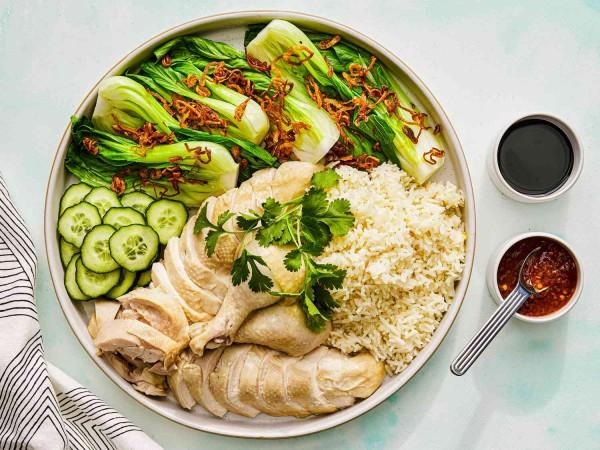
Hainanese Chicken Rice - © Serious Eats
Festivals & Local Celebrations
Hainan International Tourism Island Carnival
The Hainan International Tourism Island Carnival is a grand celebration held annually in Haikou, typically from late December to early January. This month-long festival is a showcase of Hainan’s rich cultural diversity and tourism appeal. The carnival features an array of events, including colorful parades with elaborate floats, live performances by local and international artists, and cultural exhibitions that highlight the island’s traditions and innovations. The carnival is also known for its gourmet food stalls, where you can sample both local Hainan people's specialties and international cuisines. The atmosphere is festive and lively, making it a perfect time to experience the city’s hospitality and cultural spirit.
Haikou Lantern Festival
Celebrated on the 15th day of the Chinese New Year, the Haikou Lantern Festival is a dazzling event that transforms the city into a vibrant display of lights and colors. The festival features intricately designed lanterns in various shapes and sizes, from traditional dragon and phoenix motifs to modern and whimsical designs. These lanterns are displayed in public spaces, parks, and along the streets, creating a magical ambiance that attracts both locals and tourists. In addition to the lantern displays, the festival includes traditional activities such as lion and dragon dances, folk performances, and local food stalls. The Haikou Lantern Festival is not only a visual spectacle but also a celebration of community and tradition.
Dragon Boat Festival
The Dragon Boat Festival, held on the fifth day of the fifth lunar month, is one of Haikou’s most exciting and culturally significant events. This ancient festival honors the life and death of Qu Yuan, a famous poet and statesman of the Warring States period. The highlight of the festival is the dragon boat races, where teams compete in long, narrow boats adorned with dragon heads and tails and compete for the championship on Haikou’s rivers. The festival also features traditional foods like zongzi, sticky rice dumplings wrapped in bamboo leaves, which are enjoyed by locals and visitors alike. Beyond the races, the Dragon Boat Festival includes various cultural activities, such as traditional music performances, folk art exhibitions, and community gatherings. It’s a festive occasion that brings together people of all ages to celebrate heritage and community spirit.
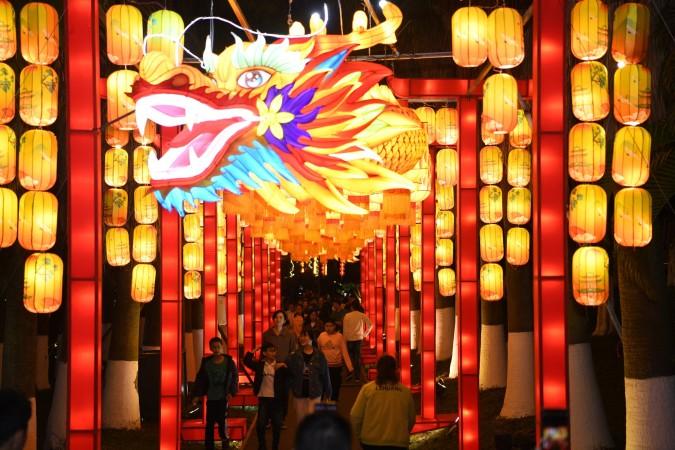
Haikou Lantern Festival - © Economic Daily China
What to Do in Haikou
Haikou offers a wide range of activities that cater to different interests, from adventure seekers to relaxation enthusiasts.
- Explore Haikou’s Beaches: There are several lovely beaches around Haikou's coastline, each providing a distinctive experience. Whether you want to relax on the soft sands of Holiday Beach or take part in water sports at Xixiu Beach Park, there’s something for everyone.
- Visit Haikou Mangrove Forest: Nature lovers should visit the Haikou Mangrove Forest, a protected area home to diverse wildlife. You can explore the forest via boardwalks and observe birds, crabs, and other animals in their natural habitat. It’s a peaceful escape into nature, just a short drive from the city center.
- Dongzhai Port Nature Reserve Cycle Tours: For an active day out, rent a bike and explore the Dongzhai Port Nature Reserve. This area is known for its scenic cycling routes that take you through mangroves, wetlands, and along the coastline. It’s a great way to see Haikou’s natural beauty up close.
- Hot Spring Wellness Retreat: Haikou is famous for its natural hot springs, and a visit to a hot spring resort is a must for relaxation. Many resorts offer outdoor pools surrounded by tropical gardens, where you can soak in mineral-rich waters and unwind after a day of exploring.
Shopping in Haikou
Shopping in Haikou is a vibrant experience, offering everything from luxury brands to local handicrafts.
- Pearl Plaza: Pearl Plaza is one of Haikou’s most popular shopping destinations, featuring a mix of international brands and local stores. It’s the perfect place to find fashion, electronics, and accessories, as well as sample local snacks at the food court.
- Haixiu Road Shopping Street: Haixiu Road is a bustling shopping street in the heart of Haikou. Here, you’ll find a variety of shops selling clothes, shoes, and souvenirs. The street comes alive in the evening, with street vendors offering local delicacies and crafts, making it a great spot for evening shopping.
- Hainan Handicraft Market: For those looking to take home a piece of Haikou’s culture, the Hainan Handicraft Market is the place to go. This market specializes in traditional crafts, such as Li brocade, coconut carvings, and pearl jewelry. It’s an excellent spot to find unique and authentic souvenirs.
- Jinma Market: Jinma Market is Haikou’s largest wholesale market, where you can find everything from fresh produce to household items at bargain prices. It’s a lively and chaotic place, offering a glimpse into the daily life of Haikou’s residents and a chance to shop like a local.
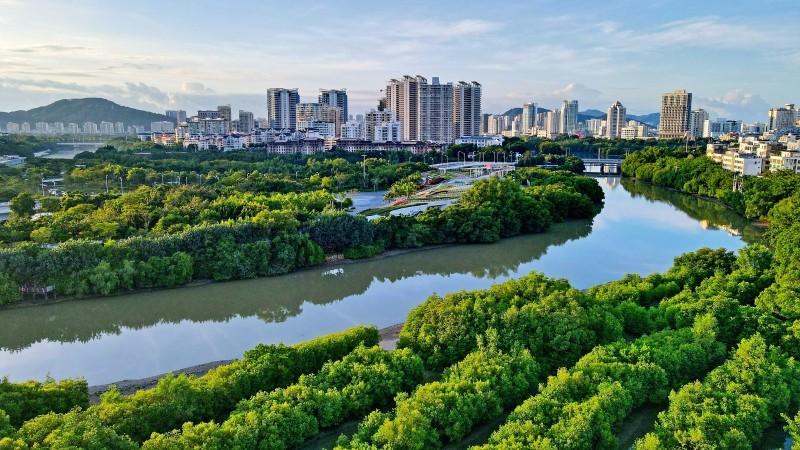
Haikou Mangrove Forest - © CGTN
Weather in Haikou: Best Time to Visit
Haikou has moderate temperatures and heavy humidity all year round due to its tropical monsoon environment.
Spring in Haikou
Spring in Haikou is mild and pleasant, with temperatures ranging from 22°C to 30°C (72°F to 86°F). This season is ideal for exploring the city as the weather is comfortable and the rainfall is relatively low. It’s a great time to enjoy outdoor activities and visit the city’s parks and beaches.
Summer in Haikou
Summer in Haikou is hot and humid, with temperatures often exceeding 30°C (86°F). This period is also the peak of the rainy season, with frequent showers and occasional typhoons. While the heat can be intense, it’s also the best time to enjoy Haikou’s beaches and water activities, though it’s advisable to stay hydrated and use sun protection.
Autumn in Haikou
Autumn brings a slight drop in temperature, making it a more comfortable time to visit Haikou. The weather is often dry with reduced humidity, and the temperature ranges from 24°C to 30°C (75°F to 86°F). This is one of the best seasons to explore the city and enjoy outdoor attractions.
Winter in Haikou
Winter in Haikou is mild and dry, with temperatures ranging from 18°C to 25°C (64°F to 77°F). It’s the coolest time of the year, making it perfect for sightseeing and outdoor activities without the discomfort of high humidity. Winter is also a popular time for tourists seeking a warm getaway from colder regions.
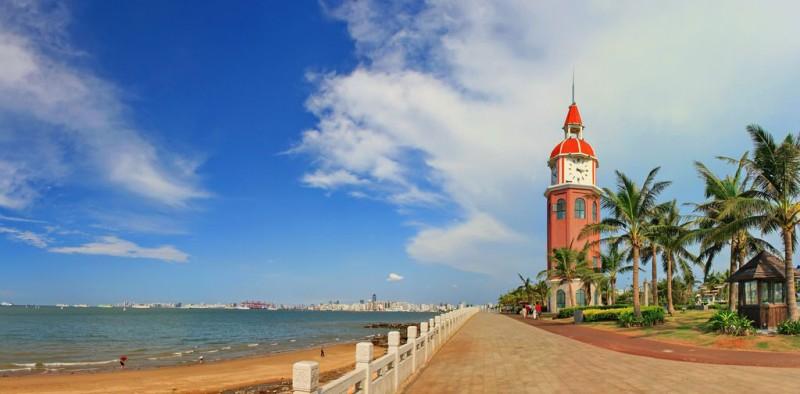
Haikou Beach in summer - © China Tourism
Culture Etiquette in Haikou
Understanding local customs and etiquette is essential for a respectful and enjoyable visit to Haikou. Here are some unique cultural norms and practices to keep in mind:
- Gift-Giving Customs: Gift-giving is an important part of social interactions in Haikou. When presenting a gift, use both hands and avoid wrapping it in white or black paper, as these colors are associated with mourning. Traditional gifts like fruits, tea, or local handicrafts are well-received.
- Proper Use of Chopsticks: Chopstick etiquette is crucial in Haikou dining culture. Never stick chopsticks upright in your rice bowl, as this resembles funeral rites. Avoid pointing with or passing food directly from one pair of chopsticks to another, which can be seen as impolite.
- Greetings: When greeting someone in Haikou, a friendly nod or handshake is appropriate. Address people with their titles and surnames, especially in formal settings.
- Respectful Dress: Dress modestly when visiting religious or cultural sites. While Haikou’s weather is warm, avoid wearing revealing clothing or hats inside temples and other sacred places. Comfortable, casual attire is acceptable for most other public places, but it's always a good idea to dress neatly and respectfully.
- Public Behavior: Maintain a calm and composed demeanor in public. Public expressions of rage or irritation are frowned upon. In social settings, be attentive to others and avoid dominating conversations. It’s also polite to queue orderly at public places like bus stops and ticket counters.
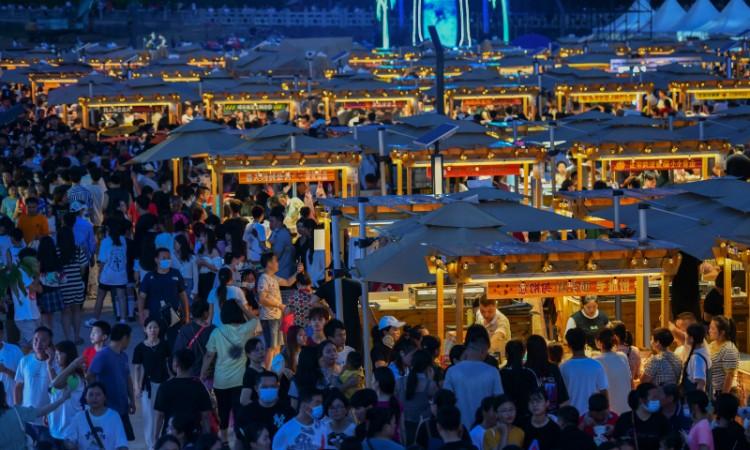
Blend in with the locals at Haikou Night Market - © Global Times
Essential Travel Information
Getting Around Haikou
Navigating Haikou is convenient with various transportation options available:
- Public Buses: Haikou boasts a comprehensive public bus network that covers the city and its surrounding areas. Buses are a budget-friendly choice for navigating the city, though they can become crowded during peak travel times.
- Taxis and Ride-Sharing Services: Taxis are easily accessible throughout Haikou and can be flagged down on the street or booked by phone. Additionally, ride-sharing services are widely used, offering a convenient way to travel around the city with set fares and real-time tracking.
- Bicycles and E-Scooters: For an eco-friendly and flexible travel option, renting bicycles or e-scooters is an excellent choice. Many parts of Haikou have designated bike lanes, making it a pleasant way to explore the city at your own pace.
- Car Rentals: For those who prefer the freedom of driving, car rentals are available at both the airport and city centers. Haikou’s well-maintained road network makes driving a convenient option for exploring beyond the city limits.
ATM & Banking Services
Haikou provides a variety of banking services for both locals and visitors. ATMs are conveniently located throughout the city, including in banks, shopping malls, and popular tourist areas, and most accept international credit and debit cards for easy access to cash in local currency. Currency exchange is available at prominent locations such as airports and hotels, though rates can vary. Major credit cards are widely accepted in hotels, restaurants, and shops, but carrying some cash is advisable for smaller transactions and local markets.
Where to Stay in Haikou
Haikou has a range of lodging options to accommodate various spending limits and tastes:
- Luxury Hotels: For a high-end experience, Haikou hosts several luxury hotels, including international chains and boutique properties. These hotels offer top-notch amenities, such as swimming pools, spa services, fine dining, and panoramic views of the city or coastline.
- Mid-Range Hotels: Mid-range hotels in Haikou provide comfortable accommodations with a range of services and often, convenient locations near major attractions. These hotels strike a balance between quality and affordability, making them suitable for both business and leisure travelers.
- Budget Hotels and Hostels: For budget-conscious travelers, Haikou also has numerous budget hotels and hostels that offer basic amenities and a friendly atmosphere. These options are often located in central areas, providing easy access to public transportation and local attractions.
Articles for you

Explore Yala National Park - Sri Lanka Travel, Asia
Tucked away in Sri Lanka’s southeastern corner, Yala National Park is where wild nature meets deep tradition. Known worldwide for its leopard population, the park is also home to elephants, sloth bears, crocodiles, and hundreds of bird species. Beyond wildlife, Yala opens doors to a cultural landscape dotted with ancient temples, Buddhist ruins, and coastal villages. For travelers seeking more than just a safari, Yala offers a chance to explore eco-tourism, local communities, and sacred heritage sites.
Population: The Yala National Park area doesn’t have a human population.
Economy: The economy around Yala National Park thrives on a blend of eco-tourism, agriculture, and local services. Safari tours, eco-lodges, and cultural experiences drive steady income for nearby towns like Tissamaharama and Kataragama, supporting thousands of families.
Landmarks: Famous for Block I of Yala and wildlife encounters, including elephants, sloth bears, crocodiles, and exotic bird species.

Explore Galle - Sri Lanka Travel, Asia
Nestled on Sri Lanka’s southern coastline, Galle is a vibrant city where history meets the sea. Its cobbled streets, colonial architecture, and serene beaches make it a must-visit destination for travelers seeking a blend of culture, adventure, and relaxation. A UNESCO World Heritage site, Galle captivates visitors with its Dutch Fort, bustling markets, and friendly locals. Whether you’re exploring the ramparts at sunset or savoring fresh seafood by the shore, Galle promises an unforgettable journey into Sri Lanka’s heritage.
Population: Approximately 113,000 in 2023.
Economy: Galle’s economy thrives on tourism, trade, and fisheries. The city’s historic fort, colonial architecture, and coastal charm draw thousands of international visitors each year, making tourism its main economic driver. Fishing remains vital for local livelihoods, supplying fresh seafood across the region.
Landmarks: Famous for the Galle Fort, Dutch Reformed Church & Maritime Museum, and Unawatuna Beach.

Explore Bentota - Sri Lanka Travel, Asia
Nestled along Sri Lanka’s southwestern coast, Bentota is a tropical paradise that blends golden beaches, vibrant culture, and thrilling adventures. Famous for its calm waters, luxury resorts, and scenic river estuary, Bentota has become a top destination for travelers seeking both relaxation and authentic experiences. From serene beach walks at sunrise to adrenaline-pumping water sports, this coastal town offers a perfect balance of leisure and exploration. With its proximity to Colombo and Galle, Bentota is easy to reach, making it an ideal stop for both short escapes and extended holidays.
Population: Approximately 37,000 in 2023.
Economy: Bentota’s economy thrives mainly on tourism, which drives local businesses such as hotels, restaurants, and wellness retreats. The town also benefits from fishing, coconut cultivation, and handicrafts like wood carving and batik textiles. Many residents rely on the growing demand for water sports and Ayurvedic treatments, making tourism the backbone of both income and employment in the area.
Landmarks: Famous for Bentota Beach, Bentota River Safari, and Kande Vihara Temple.

Explore Mirissa - Sri Lanka Travel, Asia
Mirissa is a charming coastal town on Sri Lanka’s southern shoreline. Known for its golden beaches, turquoise waters, and vibrant marine life, it has become a must-visit stop for travelers exploring the island. Many come for whale watching, surfing, and sunset views at Coconut Tree Hill, but Mirissa offers much more than postcard beauty. The fishing boats you see anchored by the bay carry generations of stories. Local traditions, delicious cuisine, and a laid-back rhythm of life shape every visitor’s experience.
Population: Approximately 4,700 in 2023.
Economy: Mirissa’s economy is largely shaped by its coastal location. Fishing has long been the backbone of local livelihoods, with generations relying on the Indian Ocean for income. In recent decades, tourism has become the main driver of growth, thanks to whale watching, surfing, and beachside hospitality.
Landmarks: Famous for Mirissa Beach, Coconut Tree Hill, and Parrot Rock Bridge.

Explore Nuwara Eliya - Sri Lanka Travel, Asia
Tucked away in the Central Highlands of Sri Lanka, Nuwara Eliya is often called “Little England”. With its rolling tea plantations, cool misty mornings, and colonial charm, this mountain town feels like a step into another world. Travelers come here to breathe fresh air, walk through flower gardens, sip the finest Ceylon Tea, and enjoy a pace of life far from the island’s busy cities. Whether you’re drawn by scenic landscapes, heritage architecture, or the warmth of its people, Nuwara Eliya is a destination that blends nature, culture, and history in perfect harmony.
Population: Approximately 781,000 in 2023.
Economy: Nuwara Eliya’s economy thrives mainly on tea production, as it sits in the heart of Sri Lanka’s central highlands, famous worldwide for Ceylon Tea. The city also benefits from a growing tourism industry, attracting visitors with its colonial charm, cool climate, and scenic landscapes.
Landmarks: Famous for Gregory Lake, Hakgala Botanical Garden, and Victoria Park.

Explore Sukau - Malaysia Travel, Asia
Nestled on the banks of the Kinabatangan River in Sabah, Malaysian Borneo, Sukau is a destination where wildlife, culture, and conservation come together. Known as one of Asia’s top spots for river safaris and eco-tourism, this quiet village offers a front-row seat to encounters with Bornean orangutans, pygmy elephants, proboscis monkeys, and exotic birdlife.
Population: Approximately 1,400 in 2019.
Economy: Sukau’s economy is shaped by its riverine location and natural resources. Traditionally, the Orang Sungai community relied on fishing, small-scale farming, and forest gathering for their livelihood. Today, the village has shifted toward eco-tourism, with river cruises, jungle trekking, and homestays providing income.
Landmarks: Famous for the Kinabatangan River cruises, Gomantong Caves, and Ox-bow lakes and wetlands.
